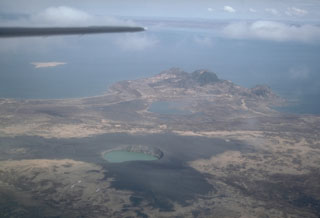Report on Ukinrek Maars (United States) — 14 April-20 April 2021
Smithsonian Institution / US Geological Survey
Weekly Volcanic Activity Report, 14 April-20 April 2021
Managing Editor: Sally Sennert.
Please cite this report as:
Global Volcanism Program, 2021. Report on Ukinrek Maars (United States) (Sennert, S, ed.). Weekly Volcanic Activity Report, 14 April-20 April 2021. Smithsonian Institution and US Geological Survey.
Ukinrek Maars
United States
57.8344°N, 156.5203°W; summit elev. 91 m
All times are local (unless otherwise noted)
AVO reported a loss of operation and communication with seismic stations that monitor Ukinrek-Maars, likely caused by snow cover. Both the Aviation Color Code and the Volcano Alert Level were changed to Unassigned on 19 April, reflecting the inability to locate earthquakes to detect unrest. Monitoring will continue with the remaining seismic stations, regional infrasound networks, lightning detection, and satellite images.
Geological Summary. Ukinrek Maars are two explosion craters that were created in an area without previous volcanic activity during a 10-day phreatomagmatic eruption March-April 1977. The basaltic maars were erupted through glacial deposits in the Bering Sea lowlands 1.5 km S of Becharof Lake and 12 km W of Peulik volcano; their location is related to the regional Bruin Bay fault. The elliptical West Maar, which was the first to form, is 105 x 170 m and 35 m deep. The other maar, 600 m to the east, is 300 m wide and 70 m deep. Both maars are now filled by crater lakes; the eastern lake encircles a 49-m-high lava dome that was emplaced at the end of the eruption. Base surges were directed primarily to the NW. Juvenile material from the Ukinrek eruptions was of mantle-derived olivine basaltic composition. The dacitic Gas Rocks lava domes, of Quaternary age, are located on the shores of Becharof Lake, 3 km N of Ukinrek maars and were the site of a phreatic eruption about 2,300 years ago.
Source: US Geological Survey Alaska Volcano Observatory (AVO)

